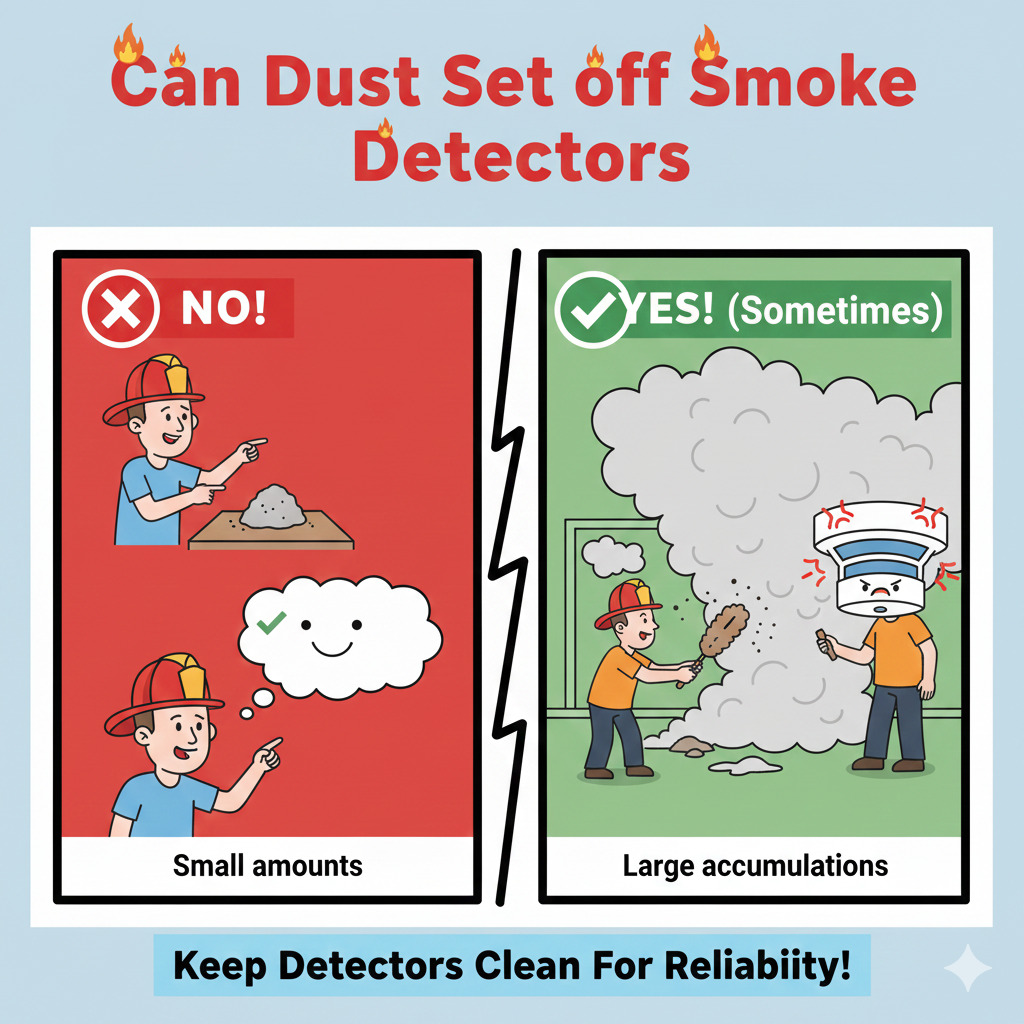
Ever wondered if that pesky dust in your house could actually set off a smoke detector? Well, I’m here to shed some light on this common question. As a seasoned expert in home safety, I’ve delved into the science behind smoke detectors and dust particles to uncover the truth.
You might be surprised to learn that dust can indeed trigger a smoke detector. But how does this happen? Join me as I break down the mechanics of smoke detectors and explore why dust accumulation can lead to false alarms. Stay tuned to find out practical tips on how to prevent this from happening in your home.
Key Takeaways
- Dust particles can trigger a smoke detector by interfering with sensors and obstructing the detector’s ability to detect smoke accurately.
- Regular maintenance and cleaning of smoke detectors are essential to prevent false alarms caused by dust accumulation.
- Smoke detectors utilize photoelectric or ionization sensors to detect smoke particles in the air, and dust buildup can significantly affect their performance.
- Dust accumulation can block sensors, lead to false alarms, and impair the overall functioning of smoke detectors, reducing their efficiency in detecting smoke particles.
- Tips to prevent false alarms include regular cleaning, using a soft brush, checking and replacing batteries, ensuring proper placement, and testing smoke detectors monthly for optimal performance.
Understanding Smoke Detectors
Smoke detectors are essential devices in any home, serving as early warning systems for potential fires. These detectors work by constantly monitoring the air for any signs of smoke particles. When smoke is detected, the alarm is triggered, alerting occupants and giving them valuable time to evacuate safely.
There are two main types of smoke detectors: ionization smoke detectors and photoelectric smoke detectors. Ionization detectors are more responsive to flaming fires, while photoelectric detectors are better at detecting smoldering fires. Some smoke detectors use a combination of both technologies for enhanced detection capabilities.
It’s important to note that dust particles can interfere with the proper functioning of smoke detectors. Dust can accumulate inside the detector over time, creating a barrier that obstructs the sensors. This build-up of dust can lead to false alarms or, in worst-case scenarios, prevent the detector from working effectively when it’s needed the most.
Regular maintenance and cleaning of smoke detectors are crucial to ensure they function correctly. Cleaning the exterior of the detector with a soft brush or vacuum attachment can help remove dust and debris. Additionally, it’s recommended to test smoke detectors monthly and replace the batteries at least once a year to ensure optimal performance.
In the next section, I’ll provide practical tips on how to prevent false alarms caused by dust accumulation in smoke detectors, helping you maintain a safe and reliable home fire detection system.
How Dust Can Trigger a Smoke Detector
Dust particles can interfere with the sensors inside smoke detectors, causing false alarms. When dust accumulates over time, it can obstruct the detector’s ability to properly detect smoke. This can lead to malfunctions and unwanted sirens going off unexpectedly.
Over time, dust buildup can also block the vents of a smoke detector, preventing the free flow of air that is necessary for the detector to function accurately. Even a thin layer of dust can compromise the detector’s performance and reduce its sensitivity to smoke.
It’s essential to recognize that dust is not just a harmless nuisance but a potential hazard for smoke detectors. Regular cleaning and maintenance are crucial to ensure that your smoke detectors are free from dust and operating effectively.
Mechanism of Smoke Detection
Smoke detectors utilize photoelectric or ionization sensors to detect smoke particles in the air.
- Photoelectric sensors work by using a light source and a light sensor. When smoke enters the detector, it scatters the light, triggering the alarm.
- Ionization sensors contain a small amount of radioactive material that ionizes the air. When smoke disrupts this ionization, the alarm is activated.
Dual-sensor smoke detectors combine both photoelectric and ionization technologies for more comprehensive smoke detection.
Regularly cleaning your smoke detectors is crucial to ensure their sensors remain clear and sensitive to smoke particles.
Effects of Dust Accumulation
Over time, dust accumulation can have a significant impact on the performance of smoke detectors. Here’s how dust can affect the operation of these crucial devices:
- Dust particles can block photoelectric sensors or ionization chambers, making it harder for the detector to detect smoke accurately.
- Excessive dust buildup might result in false alarms, disrupting occupants and potentially leading to alarm fatigue.
- In some cases, dust can even impair the overall functioning of the smoke detector, reducing its efficiency in detecting smoke particles in the air.
Regular maintenance and cleaning of smoke detectors are essential to ensure they remain free of dust and other obstructions, thereby maintaining their effectiveness in detecting smoke.
Tips to Prevent False Alarms
When it comes to ensuring the proper functioning of smoke detectors and avoiding false alarms due to dust accumulation, I’ve got you covered with some effective tips:
- Regular Maintenance: Make it a habit to clean your smoke detectors at least once every six months. Dust and debris can easily accumulate on the sensors, so keeping them clean is essential.
- Use a Soft Brush: When cleaning your smoke detectors, opt for a soft brush or a vacuum cleaner with a soft brush attachment to gently remove dust. Avoid using water or cleaning solutions, as these can damage the device.
- Check the Batteries: Don’t forget to replace the batteries in your smoke detectors at least once a year. This simple step can help ensure that your detectors are functioning optimally.
- Proper Placement: Ensure that your smoke detectors are properly positioned. Place them away from air vents, windows, and doors to minimize dust accumulation.
- Test Regularly: Test your smoke detectors monthly to check if they are working correctly. This quick test can help you identify any issues before they lead to false alarms.
By following these tips, you can reduce the risk of false alarms caused by dust accumulation and ensure that your smoke detectors are always ready to alert you in case of a real emergency.
Conclusion
Regular maintenance is key to preventing false alarms in smoke detectors caused by dust buildup. By following simple steps like gentle cleaning every six months, avoiding harsh cleaning agents, and testing monthly, you can ensure your smoke detectors are reliable in times of need. Remember, a well-maintained smoke detector can make a crucial difference in alerting you to potential dangers. Stay proactive and keep your smoke detectors in top condition to safeguard your home and loved ones.
Frequently Asked Questions
How often should smoke detectors be cleaned?
Smoke detectors should be cleaned every six months using a soft brush to prevent false alarms caused by dust accumulation.
What maintenance tips can help prevent false alarms in smoke detectors?
To prevent false alarms, avoid using water or cleaning solutions, replace batteries annually, place detectors away from dust-prone areas, and conduct monthly tests.
Why is it important to prevent false alarms in smoke detectors?
Preventing false alarms ensures that detectors function effectively during emergencies, reducing the risk of overlooking a real fire or hazard.
